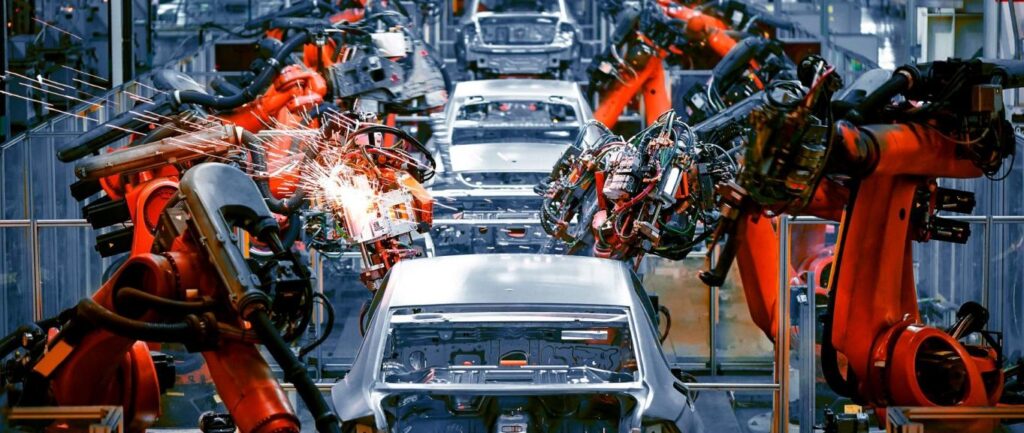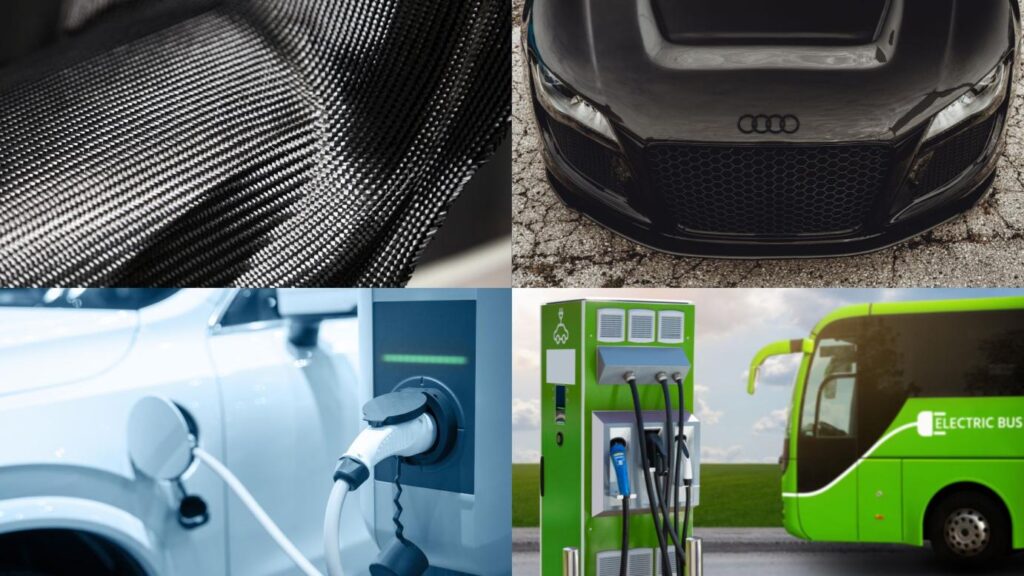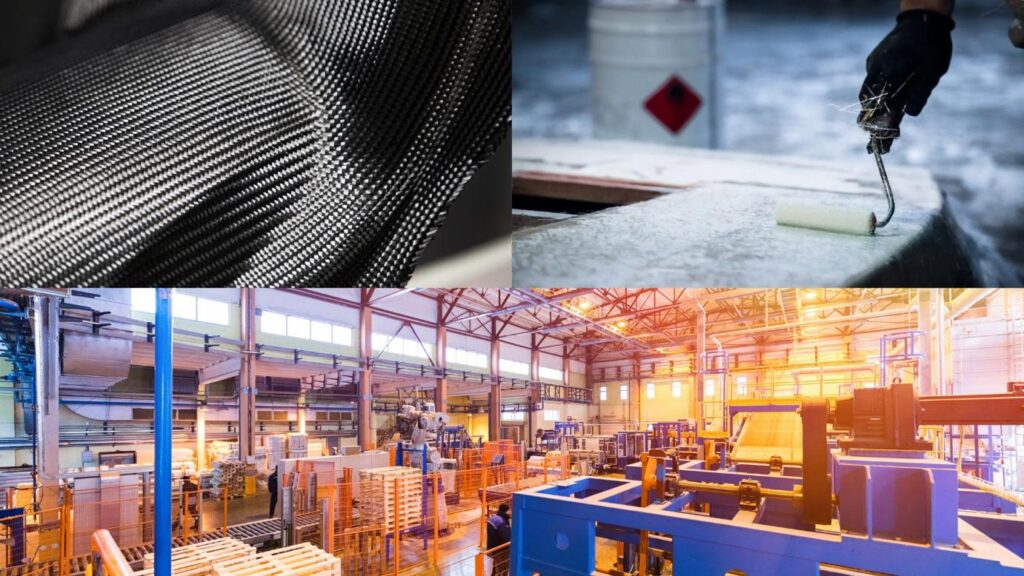
Composite materials are revolutionizing automotive design and manufacturing. Made by combining two or more constituent materials with notably different physical or chemical properties, composites offer superior strength and rigidity compared to traditional materials like steel and aluminum while weighing significantly less. This article focuses specifically on applications, advantages, and types of composites increasingly being utilized in the automotive industry. We’ll explore how composites enable greater innovation in areas ranging from body panels and structural components to wheels and powertrain systems.
The Role of Composites in Automotive Innovation
Composite materials are driving innovation across the automotive sector. Compared to legacy materials, composites provide:
- Lighter weight structures capable of meeting strict safety requirements
- Design flexibility to optimize components and achieve complex geometries
- Parts consolidation by enabling multi-functional single parts
- Cost efficiency through part and vehicle weight reduction
- Customization with greater freedom in styling and functional integration
- Sustainability via increased fuel efficiency and use of renewable materials
These benefits make composites invaluable for both evolutionary and revolutionary advancement in how automobiles are conceived, designed, and produced.
Applications of Composites in the Automotive Industry
Composite materials have diverse applications across virtually all areas of an automobile.
Body Panels and Chassis
Reinforced plastic composites are widely used for lightweight and rigid body panels (e.g. doors, hoods, trunk lids) and structural chassis components. Carbon fiber composites in particular provide the necessary strength for high-performance vehicles while reducing weight for better fuel efficiency.
Interior Components
Dashboard supports, door panels, seat backs/cushions and other interior parts often utilize glass or natural fiber reinforced polymers. The versatility of composites allows greater styling freedom for visible interior components. Parts can also be consolidated, such as a single rear seat back/cushion part replacing the multi-part metal structures used previously.
Wheels and Drive Shafts
Composite wheels made from carbon or glass fiber materials reduce critical unsprung vehicle weight to improve ride and handling. The exceptional stiffness of composites also suits them well for drive shafts to optimize powertrain efficiency.
Electric Vehicles and Autonomous Cars
The lightweight yet strong properties of composites will play an essential role in future electric and increasingly autonomous vehicles. Substantial weight reduction is required to offset battery weight in EVs; composites enable slimmer, lighter structures. Integrated sensors for autonomous functionality can also be incorporated into composite parts.
Advantages of Using Composites in Automotive Manufacturing
Several major advantages make composites highly attractive for automotive manufacturing:
Superior Strength and Rigidity
Reinforcing materials like carbon fiber give composites very high strength and stiffness-to-weight ratios. This allows lighter structures while maintaining critical vehicle safety and durability.
Formability and Design Flexibility
The constituents of composites can be tailored to achieve exceptional formability for virtually any shape. This permits greater freedom and efficiency of design to optimize styling and functionality.
Cost Efficiency
Though higher in initial material cost, composites offer long term value through part consolidation opportunities, lower tooling investment, and reduced lifecycle costs from fuel savings and durability.
Weight Reduction and Fuel Efficiency
The exceptionally low density of composites compared to traditional automotive materials directly enables vehicle weight reduction to improve energy consumption and emissions.
| Property | Steel | Aluminum | Composites |
|---|---|---|---|
| Density (g/cm3) | 7.8 | 2.7 | ~1.5 |
| Tensile Strength (MPa) | 230 | 230 | ~600 |
Table showing density and strength properties comparing steel, aluminum and polymer matrix composites.
Types of Composites Used in the Automotive Industry
The automotive industry utilizes a wide variety of composite materials, with the most common classes summarized below:
Carbon Fiber Reinforced Plastics (CFRPs)
With very high strength-to-weight ratios, carbon fiber composites feature extensively in structural and exposed body panels for high-end and electric vehicles. High cost remains a barrier to widespread adoption.
Glass Fiber Reinforced Polymers (GFRPs)
Offering good performance at relatively low cost, glass fiber composites (e.g. fiberglass) are widely used in mid to high production volume vehicles. Typical applications are leaf springs, bumper beams and wheel arches.
Thermoplastic Composites
Thermoplastic matrix composites offer advantages like recyclability and rapid manufacturing. Use remains limited but is growing for semi-structural applications like seat structures and front-end modules.
Future Trends and Innovations
Several exciting trends promise to accelerate automotive adoption of composites:
- Manufacturing process innovations to enable mass production of structural carbon fiber parts
- Advanced composite formulations for increased toughness, temperature resistance, and faster curing
- Multi-material design integration combining composites, metals and plastics for optimized structures
- Sustainability initiatives utilizing recycled/renewable reinforcements and matrices
- Digital design and production using AI and additive manufacturing to exploit benefits of composites
Conclusion
Composite materials are profoundly transforming automotive design, manufacturing, and performance. Ongoing innovation in materials, processes and manufacturing will further exploit composites to make vehicles lighter, safer, more efficient, and better customized to diverse mobility needs. The increased use of renewable composite constituents also promises to make future automotive production more sustainable.
Composite materials are revolutionizing automotive design and manufacturing. Made by combining two or more constituent materials with notably different physical or chemical properties, composites offer superior strength and rigidity compared to traditional materials like steel and aluminum while weighing significantly less. This article focuses specifically on applications, advantages, and types of composites increasingly being utilized in the automotive industry. We’ll explore how composites enable greater innovation in areas ranging from body panels and structural components to wheels and powertrain systems.
The Role of Composites in Automotive Innovation
Composite materials are driving innovation across the automotive sector. Compared to legacy materials, composites provide:
- Lighter weight structures capable of meeting strict safety requirements
- Design flexibility to optimize components and achieve complex geometries
- Parts consolidation by enabling multi-functional single parts
- Cost efficiency through part and vehicle weight reduction
- Customization with greater freedom in styling and functional integration
- Sustainability via increased fuel efficiency and use of renewable materials
These benefits make composites invaluable for both evolutionary and revolutionary advancement in how automobiles are conceived, designed, and produced.
Applications of Composites in the Automotive Industry
Composite materials have diverse applications across virtually all areas of an automobile.
Body Panels and Chassis
Reinforced plastic composites are widely used for lightweight and rigid body panels (e.g. doors, hoods, trunk lids) and structural chassis components. Carbon fiber composites in particular provide the necessary strength for high-performance vehicles while reducing weight for better fuel efficiency.
Interior Components
Dashboard supports, door panels, seat backs/cushions and other interior parts often utilize glass or natural fiber reinforced polymers. The versatility of composites allows greater styling freedom for visible interior components. Parts can also be consolidated, such as a single rear seat back/cushion part replacing the multi-part metal structures used previously.
Wheels and Drive Shafts
Composite wheels made from carbon or glass fiber materials reduce critical unsprung vehicle weight to improve ride and handling. The exceptional stiffness of composites also suits them well for drive shafts to optimize powertrain efficiency.
Electric Vehicles and Autonomous Cars
The lightweight yet strong properties of composites will play an essential role in future electric and increasingly autonomous vehicles. Substantial weight reduction is required to offset battery weight in EVs; composites enable slimmer, lighter structures. Integrated sensors for autonomous functionality can also be incorporated into composite parts.
Advantages of Using Composites in Automotive Manufacturing
Several major advantages make composites highly attractive for automotive manufacturing:
Superior Strength and Rigidity
Reinforcing materials like carbon fiber give composites very high strength and stiffness-to-weight ratios. This allows lighter structures while maintaining critical vehicle safety and durability.
Formability and Design Flexibility
The constituents of composites can be tailored to achieve exceptional formability for virtually any shape. This permits greater freedom and efficiency of design to optimize styling and functionality.
Cost Efficiency
Though higher in initial material cost, composites offer long term value through part consolidation opportunities, lower tooling investment, and reduced lifecycle costs from fuel savings and durability.
Weight Reduction and Fuel Efficiency
The exceptionally low density of composites compared to traditional automotive materials directly enables vehicle weight reduction to improve energy consumption and emissions.
| Property | Steel | Aluminum | Composites |
|---|---|---|---|
| Density (g/cm3) | 7.8 | 2.7 | ~1.5 |
| Tensile Strength (MPa) | 230 | 230 | ~600 |
Table showing density and strength properties comparing steel, aluminum and polymer matrix composites.
Types of Composites Used in the Automotive Industry
The automotive industry utilizes a wide variety of composite materials, with the most common classes summarized below:
Carbon Fiber Reinforced Plastics (CFRPs)
With very high strength-to-weight ratios, carbon fiber composites feature extensively in structural and exposed body panels for high-end and electric vehicles. High cost remains a barrier to widespread adoption.
Glass Fiber Reinforced Polymers (GFRPs)
Offering good performance at relatively low cost, glass fiber composites (e.g. fiberglass) are widely used in mid to high production volume vehicles. Typical applications are leaf springs, bumper beams and wheel arches.
Thermoplastic Composites
Thermoplastic matrix composites offer advantages like recyclability and rapid manufacturing. Use remains limited but is growing for semi-structural applications like seat structures and front-end modules.
Future Trends and Innovations
Several exciting trends promise to accelerate automotive adoption of composites:
- Manufacturing process innovations to enable mass production of structural carbon fiber parts
- Advanced composite formulations for increased toughness, temperature resistance, and faster curing
- Multi-material design integration combining composites, metals and plastics for optimized structures
- Sustainability initiatives utilizing recycled/renewable reinforcements and matrices
- Digital design and production using AI and additive manufacturing to exploit benefits of composites
Conclusion
Composite materials are profoundly transforming automotive design, manufacturing, and performance. Ongoing innovation in materials, processes and manufacturing will further exploit composites to make vehicles lighter, safer, more efficient, and better customized to diverse mobility needs. The increased use of renewable composite constituents also promises to make future automotive production more sustainable.
Role of composite materials in the development of electric vehicles
- Weight reduction – Composites like carbon fiber reinforced plastics (CFRPs) can significantly reduce the weight of electric vehicles compared to using traditional materials like steel or aluminum. This helps offset the weight of batteries and extends driving range, which addresses the issue of range anxiety with EVs.
- Structural integration – Composite materials allow for parts consolidation by enabling complex shapes and multi-functional components. For example, structural battery casings made of composites can provide crash protection while also housing the battery.
- Design flexibility – The versatility of composites gives more freedom to car designers to optimize styling and aerodynamics for EVs. Improved aerodynamics contributes to efficiency and range.
- Sensor integration – The ability to embed sensors (for autonomous driving functions) directly into composite parts during manufacture is a key advantage over traditional materials.
- Manufacturing process innovations – Automated composite manufacturing techniques like thermoplastic tapes and fibers are making higher volume production more feasible. This will help bring down costs and support mass adoption of EVs using composites.
In summary, composites are critical to developing affordable yet high-performance electric vehicles by enabling lighter weight construction, part consolidation, design flexibility, sensor integration and manufacturing innovations. The unique properties of composites address key EV development challenges.
How do composite materials affect the performance of electric vehicles
- Weight reduction: Composites like carbon fiber reinforced plastics (CFRPs) can significantly reduce the weight of EVs compared to metals. This helps offset battery weight and extends driving range. Lighter EVs also improve efficiency and performance.
- Design flexibility: The versatility of composites gives designers more freedom to optimize shapes for aerodynamics and aesthetics. Good aerodynamics contributes to driving efficiency.
- Parts consolidation: Composite materials enable complex multi-functional components. For example, a structural battery casing can provide crash protection while housing the battery.
- Manufacturing innovations: Automated composite manufacturing techniques like thermoplastic tapes help reduce costs. This supports higher production volumes needed for mass EV adoption.
- Sensor integration: The ability to embed sensors for autonomous driving functions directly into composite parts during manufacture is a key EV advantage over metals.
- Sustainability: Composites enable EVs with lower carbon footprint. Some composites also use renewable or recycled materials as reinforcement.
In summary, composites are critical enablers for mass-producing affordable yet high-performance electric vehicles to meet sustainability goals. The unique properties of composites address key EV manufacturing and performance challenges.








